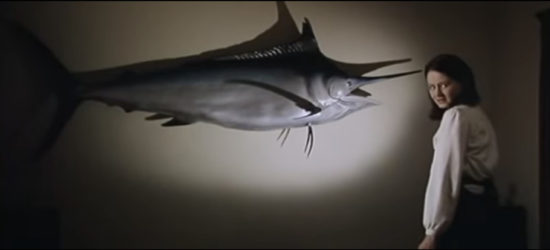Fibreglass Marlin

Set in the fictional Australian country town of Sunray, Love Serenade follows the story of two sisters. The tense, marriage-obsessed Vicki-Ann and sullen, fish-obsessed Dimity develop a fascination for their newly arrived neighbour, Ken Sherry. He is a radio DJ twice their age with a deep voice, leathery skin and a droll, sleazy manner: an unlikely heartthrob, but he captivates the sisters nonetheless.
The only decorative object in Ken Sherry’s house is a life-sized fibreglass marlin, which hangs on the living room wall. As with everything in Sunray his furnishings are decades out of date, and compared to the beige lounge chairs and mottled brown carpet the marlin has a sharp, hungry look. After an awkward conversation at the restaurant where Dimity works as a waitress, while Ken Sherry is dining alone, he invites Dimity back to his house to see it. The marlin then watches on with a beady eye as Dimity awkwardly attempts a seduction.
As the film progresses Dimity becomes more convinced Ken Sherry is part-fish — he seems to have gills, she notices, which froth up when he gargles mouthwash — the marlin seems less like a trophy and more like his familiar. The camera often cuts to it, arrested in the same static pose, its mouth open as if in permanent surprise, as if it might tell us if Ken Sherry is what Dimity suspects him to be.
The weirdness that is at Love Serenade‘s core creeps up on you. At first it seems to be driven by eccentricity, the kind that develops in lonely people, born of their frustrated desires. But as the story continues we become aware of something else, a deeper, more essential strangeness that people carry inside themselves. Given the right conditions, like this fading, stagnant country town, this strangeness rises up, like the fibreglass marlin floating against the living room wall, a fish out of water.

